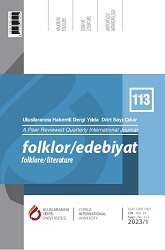Nesne Anlatıcının Klasik Türk Edebiyatından Postmodern Edebiyata Serüveni ve Bir Aryballos Hikâyesi
The Adventure an Aryballos as an Object Narrator from Classical Turkish Literature to Postmodern Literature
Author(s): Nagehan Uçan EkeSubject(s): Novel, Turkish Literature, Theory of Literature
Published by: Uluslararası Kıbrıs Üniversitesi
Keywords: object narrator; novel of circulation; classical Turkish literature; postmodern literature; aryballos;
Summary/Abstract: All narrative-based texts are essentially based on a “plot” and a “narrator”. The story’s interpretation, the language used in the story, and the author’s style are not independent from the narrator where the narrator’s crucial role in narrative literary texts inherently requires the analysis of the narrator’s the position. If this narrator is not a human being, it attracts even more attention. Some poets and writers construct characters personalities through their relations with the objects in thier works. Over time, this interest in the object, has gone further in modern texts and has enabled the object to gain the role of a “narrator”. The object narrative genre, in which inanimate objects and animals serve as conscious main characters, is known as “novel of circulation”, “it-narrative”, “object narrative”, or “object tales” in 18th century English literature. In such works, objects and animals typically appear to tell their own life stories, but in the background their biographies always concentrate on the stories of others. One of the reasons the object narrator is much admired and frequently used by writers is the ability to move between social classes in a way that no human being can and to tell the stories of people from all statuses. Writers prefer to use an object narrator due to its satirical or didactic functions. Indeed, by reflecting the situation that can be experienced by an object, the object narrator enables the reader to approach the subject from a different perspective by empathizing with it. As a matter of fact, a non-human narrator who does not have the ability to speak, breaks habits and alienates the reader, which increases both literary pleasure and the reader’s interest in the genre through a different experience. In this study, I first discuss whether there are similar examples of the object narrator tradition in classical Turkish literature, which begun with the novels of circulation in the 18th century. Then, I discuss Aryballos, a novel written by Archaeologist Prof. Dr. Güven Bakır, which is an example of circulation narratives in recent Turkish literature: A Tale about a Vase, a Black Beetle, a Thistle and a Snake (An Ancient Beautification of Izmir), in the terms of the object narrators employed.
Journal: Folklor/Edebiyat
- Issue Year: 29/2023
- Issue No: 113
- Page Range: 119-138
- Page Count: 20
- Language: Turkish

